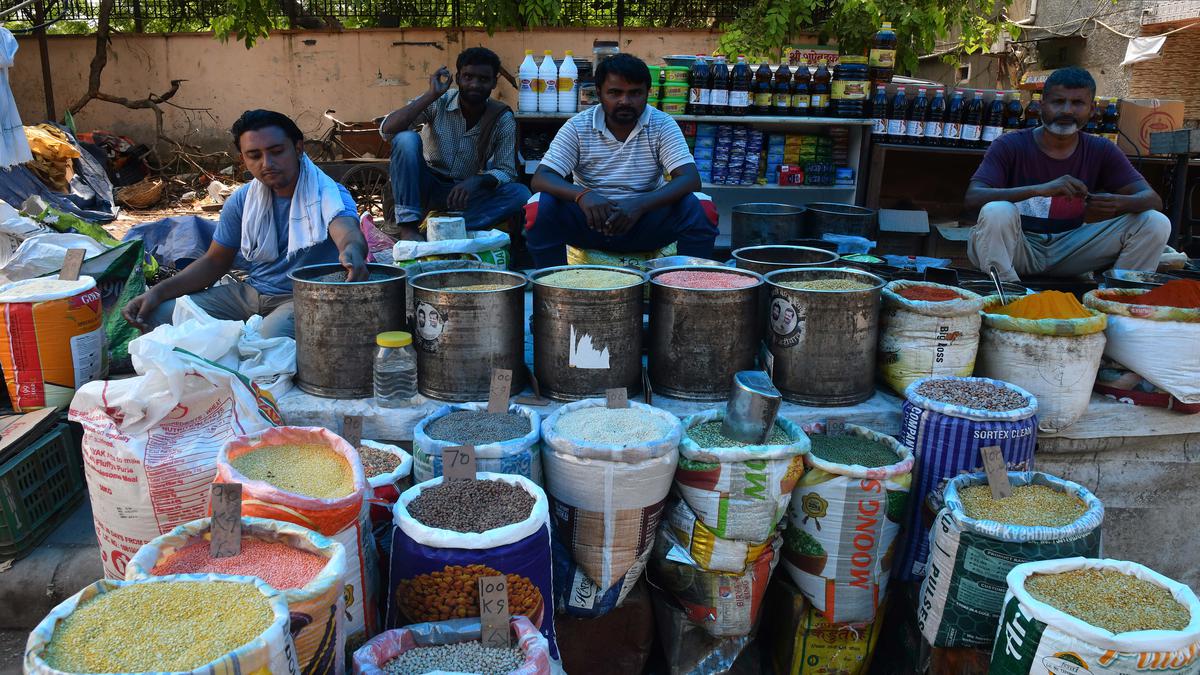Nationwide surge in food prices shows retail inflation far from tamed

Data from the Ministry of Consumer Affairs, Food and Public Distribution’s Price Monitoring Division show that prices of 9 of the 10 key food items sampled by The Hindu had increased as on June 27, 2023 from a month earlier. The price of salt alone was unchanged. File
| Photo Credit: The Hindu
A sharp increase in the retail prices of several crucial food items over the past one month — from the essential vegetables of tomato, onion and potato to the basic cereals of rice and wheat, tur dal, the commonest protein source in vegetarian households, and even loose tea — has left households and small eatery operators scrambling to juggle their budgets.
Data from the Ministry of Consumer Affairs, Food and Public Distribution’s Price Monitoring Division show that prices of 9 of the 10 key food items sampled by The Hindu — rice, wheat, tur dal, sugar, milk, tea (loose), salt (iodised, packed), potato, onion and tomato — had increased as on Tuesday from a month earlier. The price of salt alone was unchanged.
While the 0.5% month-on-month increase in milk price was the least, the prices of all three essential vegetables had risen, with potato up 8.8%, onion 11.1% higher and tomato almost twice as high as in the last week of May. The national average retail price of tomato on June 27 was ₹46.1 per kilogram, 95% higher than ₹23.6 a month earlier.
“Even a simple Rasam has become a costly dish these days,” said Prema K. P., a homemaker at Kunduparamba in Kerala’s Kozhikode, lamenting the sharp surge in tomato prices in the State.
At the Connemara market in Kerala’s capital Thiruvananthapuram, the vegetable cost ₹100 per kg on Wednesday. Only a week ago, tomato was being sold at ₹45-₹50 a kg in the State.
The price of tomato in fact was highest as per government data in Uttar Pradesh’s Gorakhpur, at ₹121 a kg as on Wednesday.
‘Seasonal factors’
Union Consumer Affairs Ministry Secretary Rohit Kumar Singh said the surge in tomato prices was the result of seasonal factors. “Across the country, tomato is grown and harvested at different points of year,” Mr. Singh told The Hindu. “There are some gaps and at some points, there will be a little shortage which gets compounded by weather disturbances. It’s also highly perishable. When it rains, transportation becomes an issue,” he added.
Traders in different parts of the country attributed the high summer temperatures this year as well as unusually sharper rain spells more recently, especially in northern States, as factors affecting the supply of vegetables this year.
“We are buying the vegetables for higher prices, we also need to ₹20-30 in profit to survive but heavy rains in the hills have ruined farmers’ crops and mandi walas are saying they are finding it difficult to procure crops,” said Ashish Gupta, a vegetable seller in Delhi. “So, now we must buy these vegetables in wholesale for higher prices,” he noted, adding that tomatoes and cauliflowers, which were sold at ₹40-50 a kg, were currently being priced in the mandi at ₹90-100 a kg.
Emphasising that the Centre was monitoring the prices on a daily basis, Mr. Singh observed that tomato prices were actually lower this year when compared with the same time of last year. “The all-India average is about ₹49 on Wednesday, which is less than last year’s price. The problem is mostly for Delhi region and the supplies will start coming from Himachal Pradesh and the issue of price rise will ease out in seven-eight days,” he added.
But consumers across the country were not so sanguine, with several pointing to the widespread nature of food price inflation that was impacting household budgets.
Srinivasan, a resident of Choolaimedu in Chennai, said vegetables including avarakkai (cluster beans), beans, brinjal and yam had all become costly and were priced above ₹100 a kg. “In such a situation, we can only afford potatoes, greens and banana stem and banana flower. The government should step in and take steps to reduce prices of all vegetables and dal, not just tomatoes,” he said.
(With inputs from bureaus in New Delhi, Bengaluru, Kochi, Vijayawada and Hyderabad)
For all the latest business News Click Here

